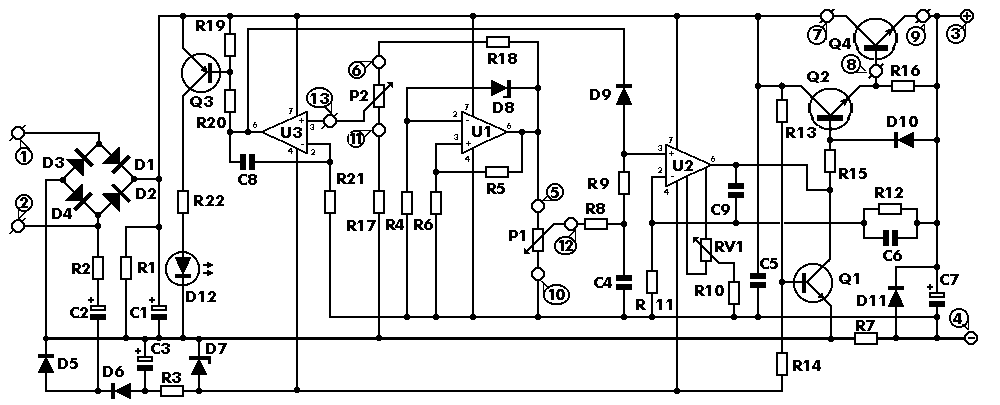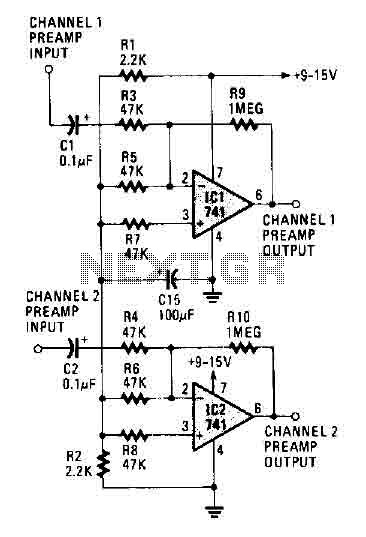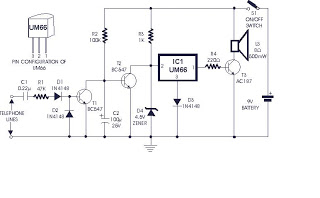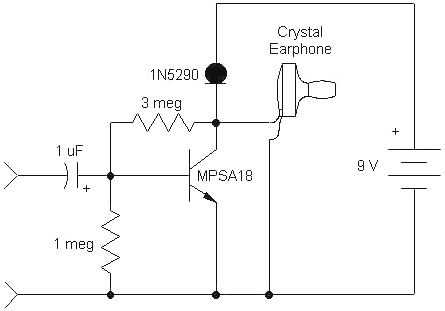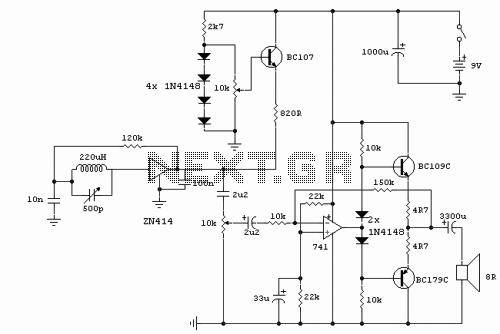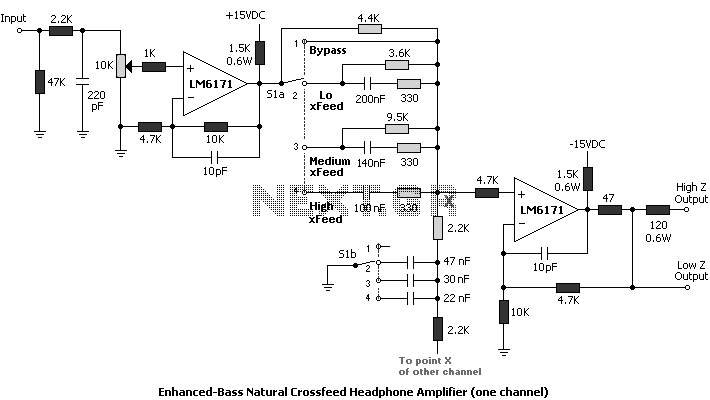
Portable Phone Preamplifier

This assembly is designed for amateurs who possess a collection of vinyl records and wish to convert them into a digital format on a personal computer. Alternatively, they may want to enjoy an old, cherished LP collection through their modern audio fidelity system, which typically lacks a phono preamp stage. This device aims to meet those needs. The assembly is powered by a 9V battery, allowing for a quick and easy connection to all high-level input preamplifier stages. The low current draw of the circuit ensures a long battery life. Despite the low voltage supply, the circuit performs well with moving magnet pick-ups, featuring high input impedance, very low noise, and accurate reproduction of the RIAA equalization curve. This is achieved through a two-stage op-amp configuration, where the RIAA equalization is split into two halves: one stage implements the bass-boost portion of the RIAA equalization circuit in a series feedback arrangement, while the second stage implements the treble-cut portion using another op-amp in a shunt feedback configuration. Battery operation also minimizes the risk of hum pickup, a potential issue often present in high-gain, high-sensitivity phono preamps. The total current draw of the circuit is approximately 1.2mA when powered by a 9V battery, and the use of a pilot lamp LED serves as the primary source of current consumption. A small, low current red LED is recommended for this purpose. With a 6.8K resistor specified for R11, the LED will draw an additional current of 1mA; it will not be overly bright but will still be easily visible. A typical carbon-zinc 9V battery will allow the circuit to operate for about 180 hours, while an alkaline battery will last for more than 250 hours. If the LED is omitted, the operating time will be approximately doubled. Additionally, for those wishing to extend battery life, the circuit can also be powered by an external power supply adapter rated at approximately 12-15V DC and 10mA or higher. In this case, the circuit's input impedance will increase further. Some components are shared between both channels and should not be duplicated. These components include R4, R5, R10, and R11, C4, C7, C8, C11, and C12, D1, D2, IC3, SW1, SW2, J3, and B1. If the battery supply is to be used exclusively, components IC3, D2, C11, C12, SW2, and J3 must be omitted, and SW1 can be replaced with a SPST toggle or slide switch.
The described assembly serves as a dedicated phono preamplifier designed to facilitate the conversion of vinyl records into digital formats, as well as to enhance playback through modern audio systems. The circuit's architecture incorporates a two-stage operational amplifier (op-amp) configuration that effectively manages the RIAA equalization curve, which is essential for accurate sound reproduction from vinyl sources. The first stage of the op-amp circuit is responsible for boosting the bass frequencies, while the second stage focuses on attenuating the treble frequencies. This division of functionality ensures a balanced output that adheres to the RIAA standard, which is critical for maintaining the integrity of the audio signal.
The choice of a 9V battery as the power source underscores the design's emphasis on portability and ease of use, while the low current consumption of 1.2mA ensures that the device can operate for extended periods without frequent battery replacements. The inclusion of an LED indicator not only provides a visual cue for power status but also serves as a practical consideration in terms of current draw. The recommended use of a 6.8K resistor for the LED ensures that the device remains energy-efficient while still offering visibility.
Furthermore, the ability to connect to an external power supply provides flexibility for users who may require extended operation times or who prefer not to rely on battery power. The design also accounts for shared components across both channels, simplifying assembly and reducing component count, which can be beneficial for both cost and space considerations in the final product.
In conclusion, the assembly is a well-thought-out solution for audiophiles and casual listeners alike, bridging the gap between vintage vinyl collections and contemporary digital audio technology. Its thoughtful design features and operational efficiency make it a valuable addition to any audio setup.This assemblage was advised for amateurs owning an old accumulating of vinyl recordings and absent to accept it digitally remastered into a claimed computer. Or sometimes they would accept to an old, invaluable, LP accumulating through their avant-garde Aerial Fidelity chain, usually defective a phono preamp stage: this is a ambit able of acceptab
le their needs. The assemblage is powered by a 9V battery, acceptance a quick and accessible affiliation to all high-level ascribe preamplifier stages and the actual low accepted cartoon of the ambit will agreement a continued array life. Despite the low voltage supply, ambit achievement with affective allurement pick-ups is absolutely good, featuring aerial ascribe afflict capability, actual low baloney and authentic reproduction of the RIAA equalization curve, acknowledgment to a two-stage op-amp chip in which the RIAA equalization arrangement was breach in two halves: an ascribe date implementing the bass-boost allotment of the RIAA equalization ambit active in a alternation acknowledgment agreement and a added stage, implementing the treble-cut allotment of the ambit by agency of a added op-amp active in the blow acknowledgment configuration.
Battery operation additionally minimizes the achievability of hum pick-up, a abeyant crisis consistently present in aerial gain, aerial acuteness phono preamps. As the absolute accepted cartoon of the ambit is about 1. 2mA back powered by a 9V battery, the use of a pilot lamp LED will be the above account of accepted consumption.
Therefore, a actual small, low accepted red LED is recommended for this purpose. Using a 6. 8K attached resistor as defined for R11, the LED will draw an added accepted of 1mA: it will not flash brightly, but can be still calmly seen. A typical, carbon-zinc, 9V array will acquiesce the ambit to accomplish for about 180 hours, admitting an acrid array will aftermost for added than 250 hours.
If the LED is omitted, durations will be about doubled. In any case, for those whishing to additional the battery, the ambit can additionally be powered by a accepted alien ability accumulation adaptor, rated at about 12-15V dc, 10mA or higher. In this case, the ambit ascribe afflict adequacy will access further. Some parts are in common to both channels and must not be doubled. These parts are: R4, R5, R10 and R11, C4, C7, C8, C11 and C12, D1, D2, IC3, SW1, SW2, J3 and B1. If you intend to use exclusively the battery supply, IC3, D2, C11, C12, SW2 and J3 must be omitted and SW1 can be substituted by a SPST Toggle or Slide Switch.
🔗 External reference
The described assembly serves as a dedicated phono preamplifier designed to facilitate the conversion of vinyl records into digital formats, as well as to enhance playback through modern audio systems. The circuit's architecture incorporates a two-stage operational amplifier (op-amp) configuration that effectively manages the RIAA equalization curve, which is essential for accurate sound reproduction from vinyl sources. The first stage of the op-amp circuit is responsible for boosting the bass frequencies, while the second stage focuses on attenuating the treble frequencies. This division of functionality ensures a balanced output that adheres to the RIAA standard, which is critical for maintaining the integrity of the audio signal.
The choice of a 9V battery as the power source underscores the design's emphasis on portability and ease of use, while the low current consumption of 1.2mA ensures that the device can operate for extended periods without frequent battery replacements. The inclusion of an LED indicator not only provides a visual cue for power status but also serves as a practical consideration in terms of current draw. The recommended use of a 6.8K resistor for the LED ensures that the device remains energy-efficient while still offering visibility.
Furthermore, the ability to connect to an external power supply provides flexibility for users who may require extended operation times or who prefer not to rely on battery power. The design also accounts for shared components across both channels, simplifying assembly and reducing component count, which can be beneficial for both cost and space considerations in the final product.
In conclusion, the assembly is a well-thought-out solution for audiophiles and casual listeners alike, bridging the gap between vintage vinyl collections and contemporary digital audio technology. Its thoughtful design features and operational efficiency make it a valuable addition to any audio setup.This assemblage was advised for amateurs owning an old accumulating of vinyl recordings and absent to accept it digitally remastered into a claimed computer. Or sometimes they would accept to an old, invaluable, LP accumulating through their avant-garde Aerial Fidelity chain, usually defective a phono preamp stage: this is a ambit able of acceptab
le their needs. The assemblage is powered by a 9V battery, acceptance a quick and accessible affiliation to all high-level ascribe preamplifier stages and the actual low accepted cartoon of the ambit will agreement a continued array life. Despite the low voltage supply, ambit achievement with affective allurement pick-ups is absolutely good, featuring aerial ascribe afflict capability, actual low baloney and authentic reproduction of the RIAA equalization curve, acknowledgment to a two-stage op-amp chip in which the RIAA equalization arrangement was breach in two halves: an ascribe date implementing the bass-boost allotment of the RIAA equalization ambit active in a alternation acknowledgment agreement and a added stage, implementing the treble-cut allotment of the ambit by agency of a added op-amp active in the blow acknowledgment configuration.
Battery operation additionally minimizes the achievability of hum pick-up, a abeyant crisis consistently present in aerial gain, aerial acuteness phono preamps. As the absolute accepted cartoon of the ambit is about 1. 2mA back powered by a 9V battery, the use of a pilot lamp LED will be the above account of accepted consumption.
Therefore, a actual small, low accepted red LED is recommended for this purpose. Using a 6. 8K attached resistor as defined for R11, the LED will draw an added accepted of 1mA: it will not flash brightly, but can be still calmly seen. A typical, carbon-zinc, 9V array will acquiesce the ambit to accomplish for about 180 hours, admitting an acrid array will aftermost for added than 250 hours.
If the LED is omitted, durations will be about doubled. In any case, for those whishing to additional the battery, the ambit can additionally be powered by a accepted alien ability accumulation adaptor, rated at about 12-15V dc, 10mA or higher. In this case, the ambit ascribe afflict adequacy will access further. Some parts are in common to both channels and must not be doubled. These parts are: R4, R5, R10 and R11, C4, C7, C8, C11 and C12, D1, D2, IC3, SW1, SW2, J3 and B1. If you intend to use exclusively the battery supply, IC3, D2, C11, C12, SW2 and J3 must be omitted and SW1 can be substituted by a SPST Toggle or Slide Switch.
🔗 External reference
